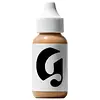What's inside
What's inside
 Key Ingredients
Key Ingredients

 Benefits
Benefits

 Concerns
Concerns

 Ingredients Side-by-side
Ingredients Side-by-side

Water
Skin ConditioningCyclopentasiloxane
EmollientCyclohexasiloxane
EmollientDimer Dilinoleyl Dimer Dilinoleate
EmollientPEG-10 Dimethicone
Skin ConditioningGlycerin
HumectantPolymethylsilsesquioxane
Alcohol
AntimicrobialDimethicone
EmollientMica
Cosmetic ColorantCaprylyl Glycol
EmollientSodium Chloride
MaskingDisteardimonium Hectorite
StabilisingChlorphenesin
AntimicrobialPropylene Carbonate
SolventBoron Nitride
AbsorbentTriethoxycaprylylsilane
Ricinus Communis Seed Oil
MaskingZea Mays Oil
EmulsifyingDiamond Powder
AbrasiveQuercus Suber Bark Extract
Skin ConditioningCI 77891
Cosmetic ColorantCI 77491
Cosmetic ColorantCI 77492
Cosmetic ColorantCI 77499
Cosmetic ColorantWater, Cyclopentasiloxane, Cyclohexasiloxane, Dimer Dilinoleyl Dimer Dilinoleate, PEG-10 Dimethicone, Glycerin, Polymethylsilsesquioxane, Alcohol, Dimethicone, Mica, Caprylyl Glycol, Sodium Chloride, Disteardimonium Hectorite, Chlorphenesin, Propylene Carbonate, Boron Nitride, Triethoxycaprylylsilane, Ricinus Communis Seed Oil, Zea Mays Oil, Diamond Powder, Quercus Suber Bark Extract, CI 77891, CI 77491, CI 77492, CI 77499
Water
Skin ConditioningCyclopentasiloxane
EmollientTitanium Dioxide
Cosmetic ColorantEthylhexyl Methoxycinnamate
UV AbsorberCyclohexasiloxane
EmollientCetyl PEG/PPG-10/1 Dimethicone
EmulsifyingButylene Glycol
Humectant4-Methylbenzylidene Camphor
UV AbsorberDibutyl Adipate
EmollientMethyl Trimethicone
Skin ConditioningZinc Oxide
Cosmetic ColorantNiacinamide
SmoothingLauryl PEG-9 Polydimethylsiloxyethyl Dimethicone
Skin ConditioningTrimethylsiloxysilicate
Emollient1,2-Hexanediol
Skin ConditioningVp/Eicosene Copolymer
Bis-Ethylhexyloxyphenol Methoxyphenyl Triazine
Skin ConditioningSodium Chloride
MaskingMica
Cosmetic ColorantSilica
AbrasiveCaprylic/Capric Glycerides
EmollientQuaternium-18 Hectorite
Hydroxyacetophenone
AntioxidantLauryl Polyglyceryl-3 Polydimethylsiloxyethyl Dimethicone
Skin ConditioningPalmitic Acid
EmollientAluminum Hydroxide
EmollientStearic Acid
CleansingTriethoxycaprylylsilane
Allantoin
Skin ConditioningParfum
MaskingAdenosine
Skin ConditioningDisodium EDTA
Xylitol
HumectantAloe Barbadensis Leaf Extract
EmollientPanthenol
Skin ConditioningMaltodextrin
AbsorbentTocopherol
AntioxidantVanilla Planifolia Fruit Extract
Skin ConditioningPhyllanthus Emblica Fruit Extract
HumectantJuniperus Communis Fruit Extract
PerfumingCI 77492
Cosmetic ColorantCI 77491
Cosmetic ColorantCI 77499
Cosmetic ColorantWater, Cyclopentasiloxane, Titanium Dioxide, Ethylhexyl Methoxycinnamate, Cyclohexasiloxane, Cetyl PEG/PPG-10/1 Dimethicone, Butylene Glycol, 4-Methylbenzylidene Camphor, Dibutyl Adipate, Methyl Trimethicone, Zinc Oxide, Niacinamide, Lauryl PEG-9 Polydimethylsiloxyethyl Dimethicone, Trimethylsiloxysilicate, 1,2-Hexanediol, Vp/Eicosene Copolymer, Bis-Ethylhexyloxyphenol Methoxyphenyl Triazine, Sodium Chloride, Mica, Silica, Caprylic/Capric Glycerides, Quaternium-18 Hectorite, Hydroxyacetophenone, Lauryl Polyglyceryl-3 Polydimethylsiloxyethyl Dimethicone, Palmitic Acid, Aluminum Hydroxide, Stearic Acid, Triethoxycaprylylsilane, Allantoin, Parfum, Adenosine, Disodium EDTA, Xylitol, Aloe Barbadensis Leaf Extract, Panthenol, Maltodextrin, Tocopherol, Vanilla Planifolia Fruit Extract, Phyllanthus Emblica Fruit Extract, Juniperus Communis Fruit Extract, CI 77492, CI 77491, CI 77499
 Reviews
Reviews

Ingredients Explained
These ingredients are found in both products.
Ingredients higher up in an ingredient list are typically present in a larger amount.
Ci 77491 is also hydrated iron III oxide. It's sole purpose is to give a red/pink hue to products.
Iron III oxides are classified as inorganic chemicals for coloring.
Synthetically created Ci 77491 is considered safer than those naturally found. This is because the synthetically created version may contain less impurities. Iron oxides are generally non-toxic and non-allergenic.
Learn more about CI 77491Ci 77492 is also hydrated iron III oxide. It's sole purpose is to give a yellow hue to products.
Iron III oxides are classified as inorganic chemicals for coloring.
Synthetically created Ci 77492 is considered safer than those naturally found. This is because the synthetically created version may contain less impurities. Iron oxides are generally non-toxic and non-allergenic.
Learn more about CI 77492Ci 77499 is also hydrated iron III oxide. It is created from mixing red and black iron oxides. This helps give shades of darkness to a product.
Iron III oxides are classified as inorganic chemicals for coloring.
Cyclohexasiloxane is a type of silicone more commonly known as D6. It is an emollient and solvent.
Cyclohexasiloxane is used to evenly distribute ingredients throughout the product. When applied to the skin, Cyclohexasiloxane evaporates and leaves behind a silky feel.
As an emollient, it can help the skin feel soft and hydrated. It is also used to reduce frizz in hair products.
Learn more about CyclohexasiloxaneCyclopentasiloxane, or D5, is a silicone used to improve texture of products and trap moisture.
D5 is considered lightweight and volatile. Volatile means it evaporates quickly after application. Once evaporated, D5 leaves a thin barrier that helps keep skin hydrated.
It is also an emollient. Emollients help soften the skin and prevent water loss. Silicones create a silky texture in products. D5 helps other ingredients become more spreadable.
Studies show D5 is safe to use in skincare products. We recommend speaking with a skincare professional if you have concerns.
Learn more about CyclopentasiloxaneMica is a naturally occurring mineral used to add shimmer and color in cosmetics. It can also help improve the texture of a product or give it an opaque, white/silver color.
Serecite is the name for very fine but ragged grains of mica.
This ingredient is often coated with metal oxides like titanium dioxide. Trace amounts of heavy metals may be found in mica, but these metals are not harmful in our personal products.
Mica has been used since prehistoric times throughout the world. Ancient Egyptian, Indian, Greek, Roman, Aztec, and Chinese civilizations have used mica.
Learn more about MicaChances are, you eat sodium chloride every day. Sodium Chloride is also known as table salt.
This ingredient has many purposes in skincare: thickener, emulsifier, and exfoliator.
You'll most likely find this ingredient in cleansers where it is used to create a gel-like texture. As an emulsifier, it also prevents ingredients from separating.
There is much debate on whether this ingredient is comedogenic. The short answer - comedogenic ratings don't tell the whole story. Learn more about comegodenic ratings here.
The concensus about this ingredient causing acne seems to be divided. Research is needed to understand if this ingredient does cause acne.
Scrubs may use salt as the primary exfoliating ingredient.
Learn more about Sodium ChlorideTriethoxycaprylylsilane is a silicone used to bind and stabilize ingredients.
As an emulsifier, it helps prevent ingredients from separating. This can help elongate the shelf life of products.
Triethoxycaprylylsilane is often used to coat mineral sunscreens ingredients to help give a better feel. It also helps reduce oxidative stress in sunscreens.
Learn more about TriethoxycaprylylsilaneWater. It's the most common cosmetic ingredient of all. You'll usually see it at the top of ingredient lists, meaning that it makes up the largest part of the product.
So why is it so popular? Water most often acts as a solvent - this means that it helps dissolve other ingredients into the formulation.
You'll also recognize water as that liquid we all need to stay alive. If you see this, drink a glass of water. Stay hydrated!
Learn more about Water